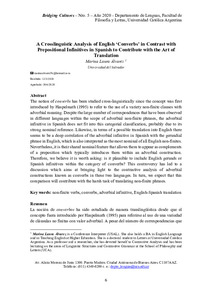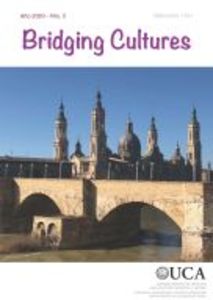Por favor, use este identificador para citar o enlazar este ítem:
https://repositorio.uca.edu.ar/handle/123456789/10999| Título: | A crosslinguistic analysis of english ‘converbs’ in contrast with prepositional infinitives in spanish to contribute with the art of translation | Autor: | Álvarez, Marina Laura | Palabras clave: | TRADUCCION; CONVERBO; INFINITIVOS PREPOSICIONALES; GRAMATICA; LENGUA INGLESA | Fecha de publicación: | 2020 | Editorial: | Universidad Católica Argentina. Facultad de Filosofía y Letras. Departamento de Lenguas | Cita: | Álvarez, M. L. A crosslinguistic analysis of english ‘converbs’ in contrast with prepositional infinitives in spanish to contribute with the art of translation [en línea]. Bridging Cultures. 2020, 5. Disponible en: https://repositorio.uca.edu.ar/handle/123456789/10999 | Resumen: | Abstract:
The notion of converbs has been studied cross-linguistically since the concept was first
introduced by Haspelmath (1995) to refer to the use of a variety non-finite clauses with
adverbial meaning. Despite the large number of correspondences that have been observed
in different languages within the scope of adverbial non-finite phrases, the adverbial
infinitive in Spanish does not fit into this categorial classification, probably due to its
strong nominal reference. Likewise, in terms of a possible translation into English there
seems to be a deep correlation of the adverbial infinitive in Spanish with the gerundial
phrase in English, which is also interpreted as the most nominal of all English non-finites.
Nevertheless, it is their shared nominal feature that allows them to appear as complements
of a preposition which typically introduces them within an adverbial construction.
Therefore, we believe it is worth asking: is it plausible to include English gerunds or
Spanish infinitives within the category of converbs? This controversy has led to a
discussion which aims at bringing light to the contrastive analysis of adverbial
constructions known as converbs in these two languages. In turn, we expect that this
comparison will contribute with the harsh task of translating non-finite phrases. Resumen: La noción de converbos ha sido estudiada de manera translingüística desde que el concepto fuera introducido por Haspelmath (1995) para referirse al uso de una variedad de cláusulas no finitas con valor adverbial. A pesar del número de correspondencias que se observan entre las diferentes lenguas que alcanzan el empleo adverbial de frases verbales no finitas, el infinitivo adverbial del español parece no ingresar en dicha clasificación categorial, probablemente debido a su fuerte referencia nominal. Asimismo, en términos de su traducción al inglés, se observa un profundo vínculo entre el infinitivo adverbial del español con la frase gerundiva del inglés, que también se interpreta como una forma netamente nominal entre las formas no finitas del inglés. Sin embargo, es justamente su capacidad nominal la que posibilita que estas formas verbales aparezcan como complementos de una preposición nexo que los introduce en la función adverbial. Por consiguiente, creemos conveniente preguntarnos: ¿es posible incluir al infinitivo preposicional del español o al gerundio del inglés dentro de la categoría de converbos? Esta controversia puede conducirnos a una discusión que logre aclarar sobre el análisis contrastivo de las construcciones adverbiales conocidas como converbos en estas dos lenguas. Además, esperamos que esta comparación contribuya con la trabajosa tarea de la traducción de las formas verbales no finitas. |
URI: | https://repositorio.uca.edu.ar/handle/123456789/10999 | ISSN: | 2525-1791 | Disciplina: | LENGUA | Derechos: | Acceso abierto | Fuente: | Bridging Cultures No.5, 2020 |
| Aparece en las colecciones: | BC - 2020 nro. 05 |
Ficheros en este ítem:
| Fichero | Descripción | Tamaño | Formato | |
|---|---|---|---|---|
| crosslinguistic-analysis-english-converbs.pdf | 227,2 kB | Adobe PDF |  Visualizar/Abrir | |
| bridging-cultures5.jpg | 5,96 kB | JPEG |  Visualizar/Abrir |
Visualizaciones de página(s)
101
comprobado en 30-abr-2024
Descarga(s)
158
comprobado en 30-abr-2024
Google ScholarTM
Ver en Google Scholar
Este ítem está sujeto a una Licencia Creative Commons

